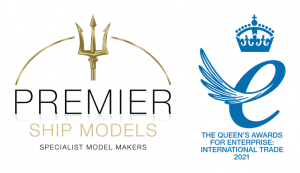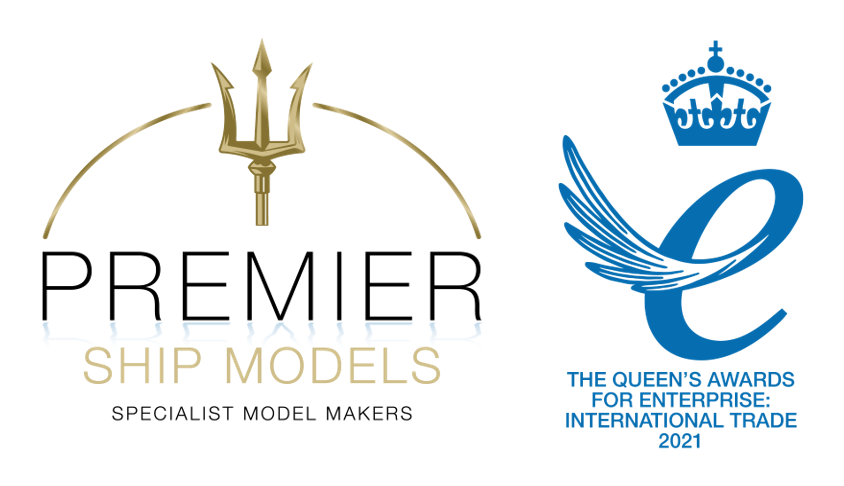We have just completed an order for eight Purus Horizon model ships (formerly called the Edda Passat), with three being identical and measuring 38 centimetres in length, 16 in width and 22 in height, and five being larger and measuring 118 centimetres in length. The three small models were constructed by our offsite 3D-printing specialist, and they complete the first part of the order, with the remaining five large models making up the second part, being built in our workshop.
All of the smaller models are fitted with an acrylic display case for added protection, and they are complete with a striking white and navy-blue colour scheme, atop a crisp wooden base.
The Purus Horizon was previously owned by Edda Winds, and was called the Edda Passat as stated above. It was acquired by Purus, and renamed so it could join their fleet of construction and service operation vessels.
It’s an incredibly versatile ship that can carry out a number of different tasks throughout various construction and operations phases; such as transporting important components, providing accommodation, and also serving as a platform for cranes.
The client for this project was Purus themselves. Purus leads the way in offering maritime services to global energy customers, specializing in gas transport and offshore wind industries.
They boast one of the world’s largest and newest fleets of gas carriers, construction service operation vessels and crew transfer vessels.
At the forefront of maritime decarbonization, they utilize technologies like clean fuels, energy-saving devices, electrification, and carbon capture systems.
With six offices and one operational hub worldwide, Purus provides comprehensive technical and commercial ship management, as well as vessel design, contracting, newbuild supervision, and crewing services.
These models were to be 3D printed, and then finished by hand. As stated in the overview, the smaller ones each measured 38 centimetres in length, 16 in width and 22 in height (excluding the base), and the larger ones measured 118 centimetres in length.
Regarding materials used, the models were solely constructed from wood and fibre glass, with chrome used for smaller sections for some added flair.
3D-printing is an incredibly complex profession. It requires you to understand three main things:
- The material
- The printer
- The methodology of the piece and your desired end result
The entire process is extremely specialist. Our off-site 3D-printing agent focuses on two skillsets when constructing models: creating the model in a digital manner and readying it for printing, and the separate skillset to take the parts from the printer and get them to a professionally high-standard.
Our bespoke projects always start with detailed discussions between us and our clients to ensure we are aligned and can realise their vision exactly as they imagine. We strongly value transparency, providing our clients with regular updates on the progress of their order and collaboratively deciding on details such as delivery schedules and payment terms.
With our emphasis on 3D printing, the process begins by creating a digital model. We procure high-quality materials as specified in the overview and project brief, and then employ 3D simulation modelling and laser-cutting for maximum accuracy.
To maintain efficiency, we temporarily pause production so our clients can approve the digital render or offer feedback. Once approval is given, we proceed swiftly to save both time and resources.
A particularly challenging aspect is preparing the digital render for the 3D printer, which necessitates specialised software. We divide the render into manageable sections, each representing a part of the model, and ensure they are properly labelled and organised. Advanced software is used to verify the parts for correct sizing, strength, and waterproofing.
After finalising the render, we move on to laser-cutting and then begin the construction process. This hands-on phase, known as ‘finishing’, requires highly skilled and experienced craftsmanship. Typically, we divide the hull into three sections with joints that are glued together and left to dry before adding further details. The hull is primed first to ensure structural integrity.
Meanwhile, our 3D expert prepares and paints smaller components individually.
From start to finish throughout the entire process, we keep our clients informed with plenty of photos and updates. Ensuring our clients’ satisfaction is our highest priority, and we welcome and incorporate their feedback to achieve the desired result.
For this particular project, we provided the smaller models with acrylic display cases for extra protection and to ensure their longevity. They were completed with a striking navy blue and white paint scheme, a burgundy hull with white lettering, and a clean wooden base for support.
Purus were left absolutely thrilled with the final models, and were pleased with the communication levels during the entire project.
It was an honour to work on model renditions of the fantastic Purus Horizon, and a privilege to be able to bring their vision to life! Now, we eagerly shift our focus to other upcoming projects!
Commission your own model
If you would like to have your own bespoke model built, please complete the contact form below.


